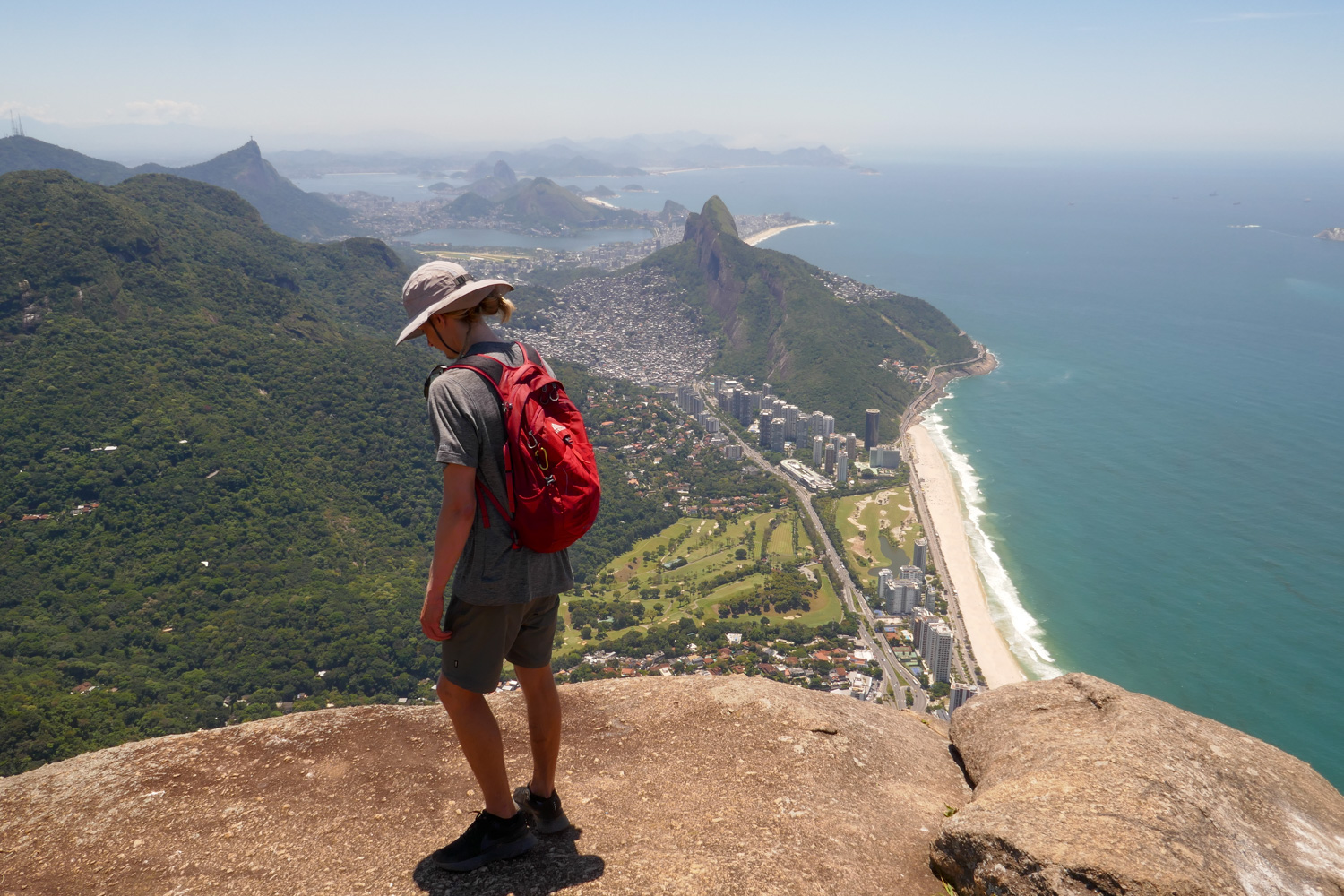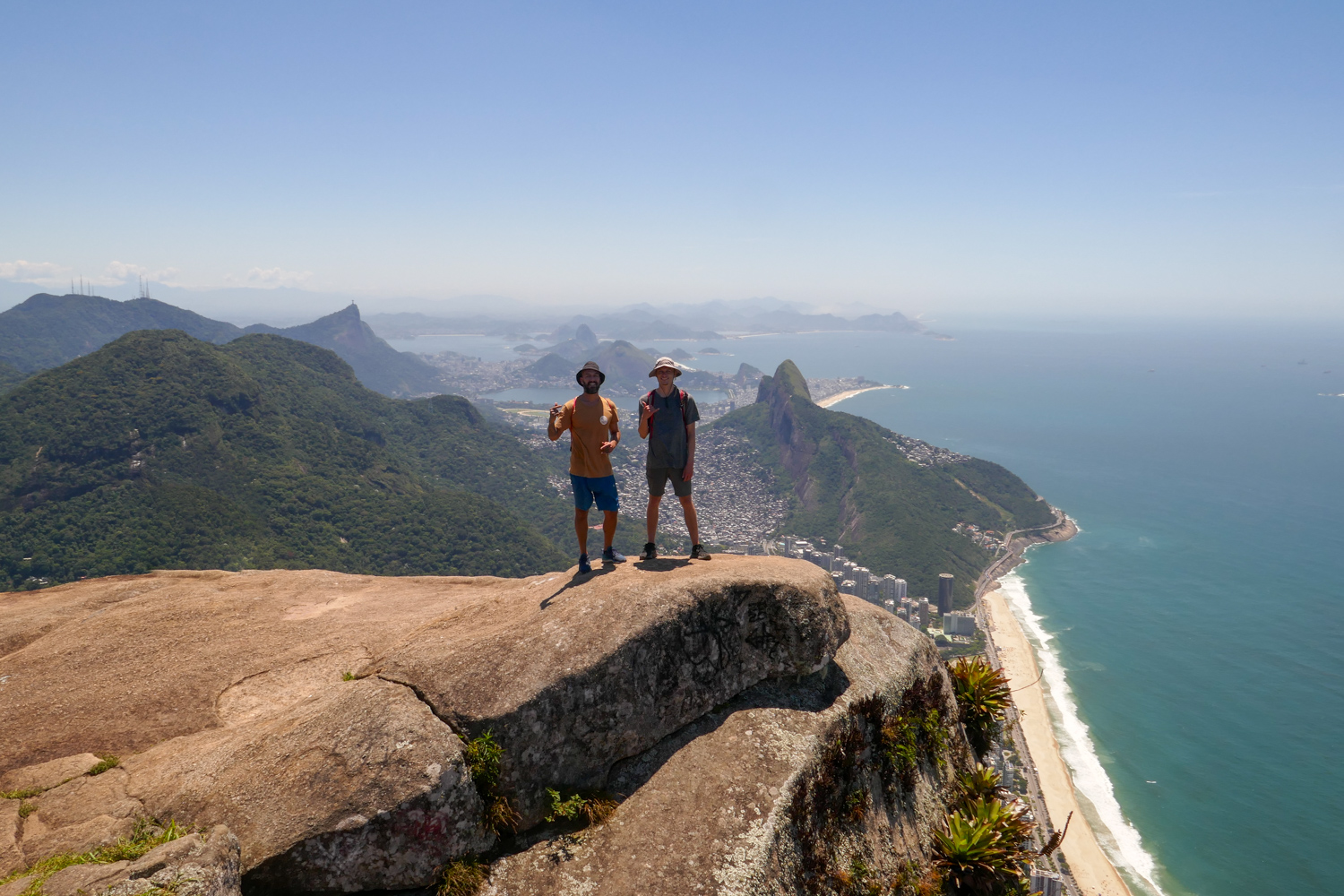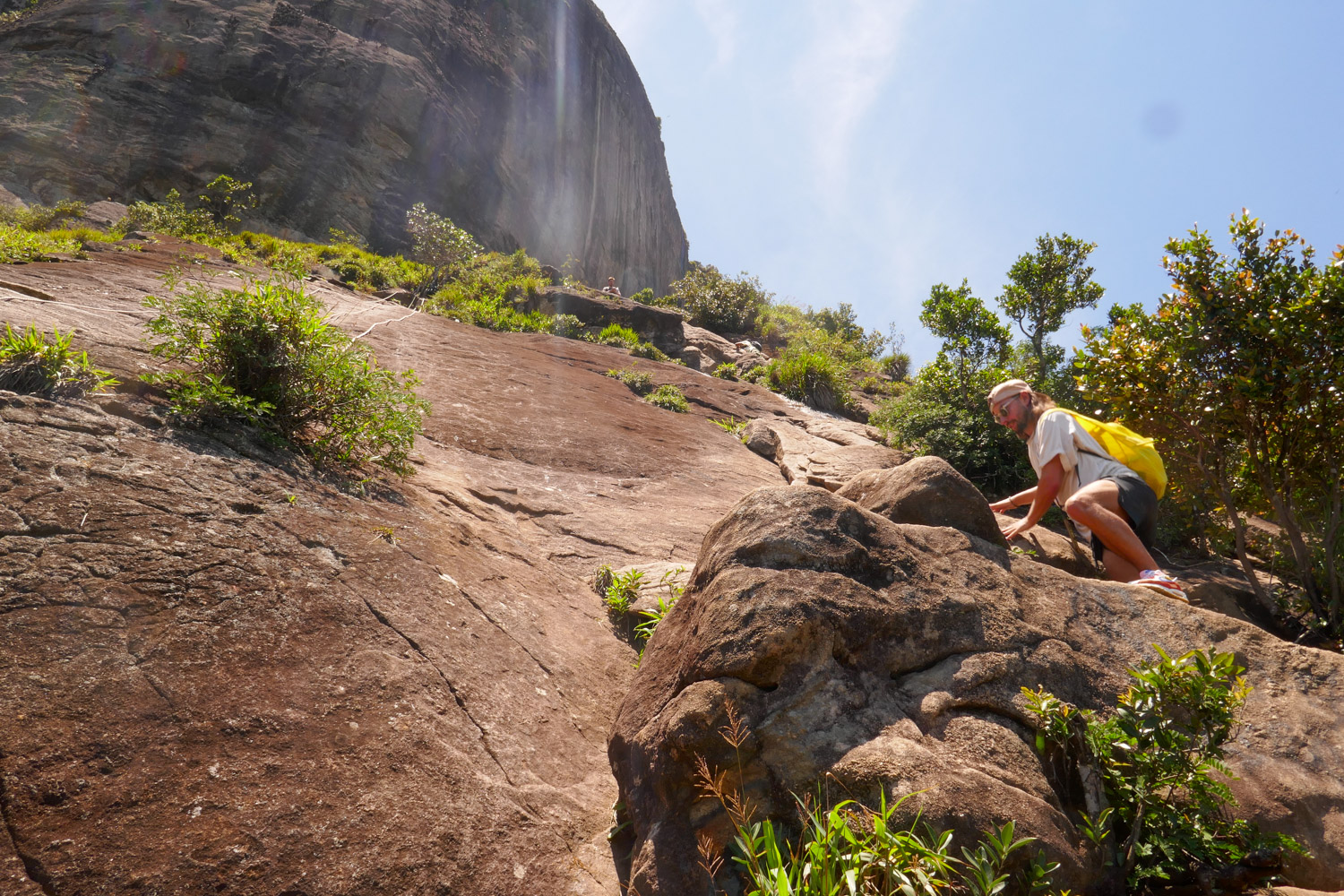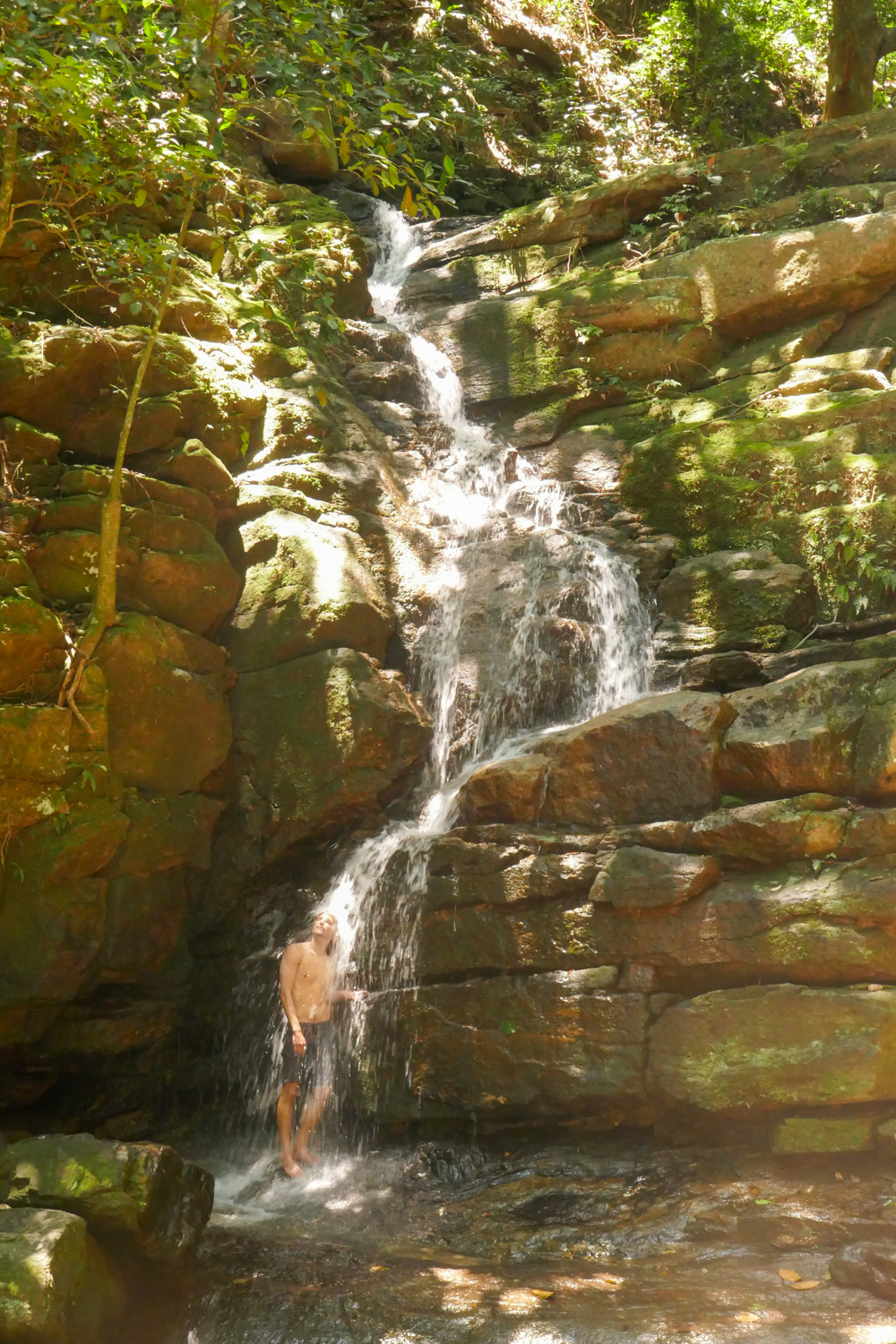
When my plane first touched down in Rio de Janeiro and my senses began to take in my surroundings, it was hard not to miss the magnificent granite monoliths that dot the city’s shore.
Towering towards the sky nearly straight out of the ocean, these large hunks of rock are the signature landmarks that create Rio de Janeiro’s world renowned skyline. It reminds me of Yosemite Valley plopped on a tropical beach. There are few places in the world that compare.
Naturally, as I was peering up to these peaks, I pondered a few key questions, such as “Which is biggest?” and “Which can I hike?”
A quick dive online and some chats with locals soon fixed my attention on Pedra da Gávea, a 2,700+ foot behemoth on the western beaches of the city. This peak just happens to also loom over the apartment that I’ve been living in, with the trailhead just a convenient mile-walk from my front door.
After a few days of staring up at Pedra da Gávea’s unique form, prominence, and height, I had seen enough. I did my typical pre-hike research dive on the internet to learn all I needed to know about safely getting to the top of the mountain.


Trek to the top
The first step to conquering Pedra da Gávea was finding a hiking partner, which was easy. My Brazilian friend and roommate Kaleu had done it before and upon my inquiring, wanted to go again.
However, he didn’t really remember much about the trail and wanted to find someone more familiar with it. He enlisted the help of his friend Gustavo, who has hiked the trail hundreds of times, mainly for the purpose of BASE jumping off the top.
Next step: when to hike.
There were two key factors that played into when we chose to do the hike. First, we were looking for a multiple day window without rain, which during Brazil’s rainy summer season, can require some patience.
It’s especially crucial to wait for a few days of no rain to give the trail some time to dry out. If you go right after a rain you’ll be hiking on mud and slippery granite, which is not ideal.
Additionally, we also wanted to choose a window that would minimize the risk of becoming victims of a robbery. Unfortunately, there have been reports of hold-ups on the trail — thieves taking advantage of the remote trail networks to shake down hikers for valuables. It’s the reality of hiking within a secluded forest so closely bordered by a densely populated metropolitan area.
Gustavo, our guide, informed us that weekday mornings are low risk to run into such trouble. With this information in hand and the luxury of living at the base of the mountain, we waited for the stars to align for the perfect hiking day. After checking the forecast we decided to give it a go on a sunny, November morning.
A trudge through the rainforest
We rose bright and early, packing our bags and heading to the trailhead at the southern entrance to Tijuca National Forest.
We hopped on the trail and commenced the hike — a short but strenuous trek that climbs more than 2,300 feet in just a mile and a half. It’s a stair master, muscle-burner type of a hike, never giving your calves a chance to catch a break.
The trail quickly ascends through the moist rainforest, completely shaded by thick canopy.
I was enjoying the scenery, observing the exotic flora and fauna. Pumpkin-sized jackfruit abundantly hung from trees, yellow-bellied birds chirped on branches, and camouflaged Walking Sticks crawled around decaying foliage.



While the scenery was exciting, tropical hiking is a whole different animal. The humid air and dense, wind-protected forest make for sticky, unpleasant conditions. I have been too spoiled by California’s dry, temperate weather. In the tropics, you have to embrace the sweat, which begins to pour out as soon as your body performs the most minor amount of physical exertion.
After the quick, yet exhausting climb the trail pops out into a clearing and the impressively steep rock walls of the peak come into view.
It’s at this point of the hike where the trail’s most infamous obstacle awaits: the Carrasqueira.

Navigating the Carrasqueira
The Carrasqueira is almost as renowned as the peak itself.
After a mile or so of reasonably steep trail, you encounter a steep wall of rock known as the Carrasqueira. This 100ft section of the trail is inclined at such an angle that it is possible to climb without ropes, but still steep enough that a fall would not end well.
Many opt to hire a guide with climbing ropes to tackle the Carrasqueira, but for those with reasonably adept climbing skills, it’s probably not necessary. Still, at the very least you should hike with a partner to support you on this section.
Kaleu and I let Gustavo take the lead, who navigated the route like a mountain goat, seemingly having memorized every hold to scale the rock. Mimicking his lead, we were at the top in no time.
I did my best to remember the path we took since Gustavo was going to BASE jump from the top. We would be on our own to retrace our steps on the return trip, which undoubtedly would be trickier than the climb up.
Standing on the summit
With the Carrasqueira in the rearview mirror, it was just a quick hike further to reach the top of Pedra da Gávea.
The top of the mountain is an interesting two-pronged peak, with a cleft in the middle dividing the two sides. The mountain top was noticeably formed from a different geologic process than the rest of the mountain. An enormous, flat chunk of granite sits on the top of the dome, reminiscent of the top of a layered wedding cake.
The early Portuguese explorers named the peak Pedra da Gávea — literally translated to “topsail rock” — due to the mountain’s resemblance to the form of a ship’s sail.
The south side of the peak is the classic panoramic spot where you get the sweeping city and ocean views. But before we went to the south side to get our photos, we followed Gustavo to the north peak which features a more vertical face that is used for BASE jumping.
We perched on the edge of the cliff and watched Gustavo jump into oblivion, gliding in his parachute thousands of feet down to the beach below. As much fun as I’m sure he had, these types of action sports don’t really appeal to me. I’ll stick with hiking and surfing.
After enjoying the spectacle we headed back to the south side to enjoy the views. From the top you can see all the prominent peaks and miles of white sand beaches of Rio.
It’s a worthy spot to appreciate one of the most picturesque cities in the world.


The Carrasqueira round 2
Once the views were sufficiently taken in, we headed back down the mountain. We knew that we couldn’t celebrate our hike until we descended the Carrasqueira.
Now without Gustavo, we assembled a little team to tackle the precarious descent. I grouped with a Czech guy that we met on the trail and a Brazilian woman who knew the route well.
Kaleu jumped on the opportunity to mooch off the ropes of a guide group that happened to be going up as we were headed down, but the rest of us felt confident enough to climb down rope-free.
The Brazilian woman went first at a pace that would have made me uncomfortable. She was bouncing from hold to hold, seemingly before even confirming that her grips were solid.
Next went our Czech friend, who was extremely tall (about 6’4” or 5” if I had to guess). I watched him struggle a bit to reach the holds, relying heavily on the advice of the woman who was below him.
Watching him struggle made me realize how much more of a challenge the descent would be compared to the ascent.

When I began the down climb I discovered for myself the challenge presenting those below. Many of the foot holds are within the rock, not protruding from the rock. With the perspective from above, you are unable to judge exactly where a safe place to put your foot is.
I went slowly and cautiously, relying on the aid of those below me to confirm that the hole I had placed my foot in was in fact a strong hold. You don’t want to rely on a bad foot hold when you are reaching so far.
After a few tense moments, teamwork prevailed and we were all down to the safety of dirt on the trail below. Now we could confidently celebrate our achievement before scurrying down the mountain.
As a bonus reward for completing the hike, there is a modest waterfall at the bottom that we all gladly used as a shower to remove the layers of sticky filth that had accumulated on our skin.
It was a perfect end to an amazing hike.

Final thoughts
I wasn’t sure how much hiking I’d end up doing in Brazil, so I was happy to be able to complete such a worthy trek.
However, humid hiking is not only unpleasant, but it’s dangerous given how fast your body dehydrates. I don’t think I’ll be looking for any mega-hikes longer than that one (especially during summertime). A half day hike was perfect in my book.
For those reading this post thinking that they might want to do the hike, I’d say go for it! But first take a good hard look at yourself and think about how athletic and coordinated you are. If you are a stellar hiker, you’ll have no problem. If you overestimate your skills, you might run into issues.
If you don’t think you can make the cut, I’d recommend hiring a reputable guide company to guarantee a safe summit.
Most tourists flock to Cristo Redentor to get their aerial views of Rio, but Pedra da Gávea is a great option to get those same views without the shoulder to shoulder crowds. It’s a must for those who prefer the outdoors when visiting Rio.
This may be posted twice but I don’t think it worked the first time? Loved reading about your thrilling hike. After you suggested a self-assessment before climbing, I dediced this was probably not for me. I’m going to stick to trying to get up and down the stairs. Anyway, hope you continue to enjoy your trip and thanks for taking a shut-in on a fun adventure. Have a great New Year, Evan. Love you!
LikeLike
Thanks for the interesting tour. Enjoyed it. Be safe.
LikeLiked by 1 person
Glad you and your computer are reunited. Thanks for sharing this adventure. Looks like great fun and vistas are amazing.
Love and miss you! (Also relieved base jumping does not appeal to you.)
Mom
LikeLiked by 1 person
Mae! Hubieras hecho base jump! Jaja muy bueno!
LikeLiked by 1 person